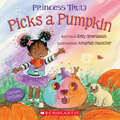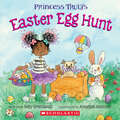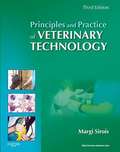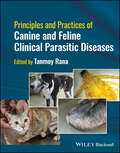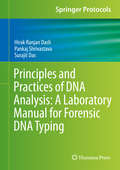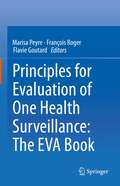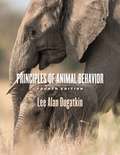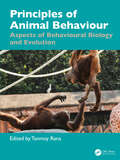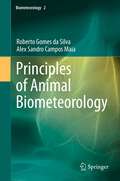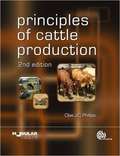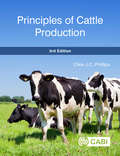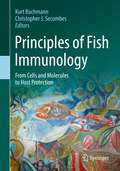- Table View
- List View
Princess Smartypants and the Fairy Geek Mothers (Princess Smartypants #2)
by Babette ColePrincess Smartpant's long lost Fairy God Mother Doris needs her help...In Fairy tale land, Fairy God Mothers are being made redundant, and replaced by Fairy Geek Mothers. All traditional Fairy God Mothers grant everyone three nice wishes. But the Fairy Geek Mothers have their own website where people can buy wishes online... what could possibly go wrong? Well, in Fairy Tale Land, it's the fairy tales which are suffering. For example, Princess Beatrice has bought a wish: to magic an ugly wart on her sister's nose, and her sister is annoyed, to say the least. Meanwhile, Goldilocks has a sore tummy because certain bears have wished for her porridge to go bad. If the fairy tales don't get fixed, children will never know the real ones! Can Princess Smartpants help Doris find a way to make fairy tales good again?
Princess Truly Builds a Snowman (Princess Truly)
by Kelly GreenawaltJoin Princess Truly and her magical, sparkling curly hair as she brings her snowman to life!Favorite character Princess Truly, her brother Ty, and her dog, Sir Noodles build an amazing snowman that comes to life. Together, they have the perfect winter day filled with skating and games! But when it's time for Princess Truly to go home, their snowman gets lonely! With a shake of her magical, sparkling curls, Princess Truly makes her snowman a new snow-friend!Told in sweet rhyming text and with adorable illustrations, Princess Truly Builds a Snowman is the perfect winter story for your little one!Princes Truly books promote messages of empowerment, confidence, and a positive self-image. Collect them all!
Princess Truly Picks a Pumpkin (Princess Truly)
by Kelly GreenawaltTake a magical trip to the pumpkin patch with Princess Truly and her magical, sparkling curly hair!Join favorite character Princess Truly and her dog, Sir Noodles, on a trip to the pumpkin patch! Princess Truly wants to find a marvelous pumpkin that is extra special. But all the pumpkins in the patch are ordinary, orange and round! With a shake of her magical, sparkling curls, Princess Truly creates a pumpkin that is just-right: a RAINBOW pumpkin!Told in sweet rhyming text and with adorable illustrations, Princess Truly Picks a Pumpkin is the perfect fall story for your little one!Princes Truly books promote messages of empowerment, confidence, and a positive self-image. Collect them all!
Princess Truly in My Magical, Sparkling Curls (Princess Truly)
by Kelly GreenawaltIn her second adventure, Princess Truly's magical curls and belief in herself transport her back in time and help her reach for the stars!I love my fluffy, puffy curls.I'm so happy they are mine.When I believe in myself,They shimmer and they shine.Princess Truly is back! In the second Princess Truly adventure, Truly's magical, sparkling curls have the power to transport her to exciting new places like the Egyptian pyramids, the Jurassic period, and even into outer space. With curiosity, bravery, and her signature smarts, Princess Truly once again proves that she can do anything she sets her mind to and reminds girls everywhere to reach for the stars, believe in themselves, and dream big!
Princess Truly's Easter Egg Hunt (Princess Truly)
by Kelly GreenawaltJoin Princess Truly on a magical Easter egg hunt!It's time for an Easter party! Princess Truly and her dog, Sir Noodles, are on the hunt for eggs and treats. There's a special guest at the party -- the Easter Bunny! But when it's the Easter Bunny's time to go, his wagon gets stuck! Princess Truly knows exactly what to do. With a shake of her magical, sparkling curls, she helps the Easter Bunny get on his way and saves the day!With its sweet rhyming text and adorable illustrations, Princess Truly's Easter Egg Hunt is the perfect Easter basket gift and springtime read!
Princess and the Frog (Disney Princess and the Frog)
by RH DisneyWalt Disney Pictures presents The Princess and the Frog. . . .Tiana is a beautiful, hardworking young woman with a dream. Naveen is a spoiled, jazz-loving prince who doesn’t understand the meaning of hard work. This unlikely pair has nothing in common—until they are magically transformed into frogs! Forced to work together as they set out to regain their human forms, will Naveen and Tiana eventually find true love in each other? Disney’s fresh take on an old fairy tale reminds us all that true beauty is more than skin deep and dreams really do come true. This hardcover Read-Aloud Storybook retells the heartwarming feature film with dazzling full-color art.
Princesses Versus Dinosaurs
by Linda BaileyTwo popular storybook titans, princesses and dinosaurs, battle to determine who should star in this laugh-out-loud picture book for fans of Shark vs Train and The Book With No Pictures.This is a princess book!No, it's a dinosaur book!No, it's . . . a T. rex book? A dragon book? A rubber ducky book?!From Linda Bailey, award-winning and critically acclaimed author, and Joy Ang, Adventure Time-artist and illustrator of the Mustache Baby series, comes an irresistibly irreverent picture book in which plucky princesses and determined dinosaurs have a battle royale over whose book this is. When they start calling in the big guns -- or rather, the big carnivores -- and decide to build a wall to resolve their differences, princesses and dinosaurs alike learn a thing or two about open-mindedness and sharing.
Principles and Applications of Domestic Animal Behavior
by Edward PriceIn order to understand and manage animals in their natural or captive environments we must first understand why animals do what they do and recognize limitations in their ability to adapt to different environments. Drawing on the author's considerable experience in both teaching and research, this introductory-level textbook describes the basic principles underlying animal behavior and how those concepts can be used in managing the care of domestic and captive wild animals, covering four key themes: development of behavior, biological rhythms, social behavior and behavioral aspects of animal management. Extensively illustrated with many practical examples and over 150 photos and figures.
Principles and Practice of Veterinary Technology (3rd Edition)
by Margi SiroisPrinciples and Practice of Veterinary Technology provides comprehensive coverage of the competencies every vet tech needs to know and offers excellent preparation for clinical practice and for veterinary technician credentialing examinations. This third edition has been designed primarily for the veterinary technician student with a particular focus on providing a ready reference on the diverse information that will be needed once the student graduates and begins working in the field.
Principles and Practices of Canine and Feline Clinical Parasitic Diseases
by Tanmoy RanaPrinciples and Practices of Canine and Feline Clinical Parasitic Diseases A comprehensive reference guide for specialists highlighting the parasitic diseases of dogs and cats with appropriate therapeutic strategy Parasitic diseases are a scourge for dogs and cats, and the impact of the numerous maladies associated with these diseases cannot be underestimated. For the clinician or researcher attempting to alleviate these symptoms, Principles and Practices of Canine and Feline Clinical Parasitic Diseases is a helpful, introductory practical guidebook that helps identify the parasites infecting these animals and suggests useful treatment strategies based on an appropriate diagnosis. Principles and Practices of Canine and Feline Clinical Parasitic Diseases comprehensively details its topic from symbiosis and parasitism, to therapeutics measures and control strategies, to the deleterious effect of parasites in various organs in dogs and cats. The book offers extensive information on management approaches, the most significant clinical findings, diagnostic approaches, disease prevention, and drug evaluation. As a reference, the guide provides systems for the identification of the pathogens and recognizes the severity and exhibition of disease manifestation. Principles and Practices of Canine and Feline Clinical Parasitic Diseases readers will also find: Preventative measures that can be utilized to prophylactically assure the continued health of the patient Chapters written by contributors with specialized knowledge in each particular subject presented The most up-to-date advanced research in the field of parasitic diseases Each chapter covers treatment schedules, details about the disease, and a management approach, using figures and line figures to aid in identification and treatment Principles and Practices of Canine and Feline Clinical Parasitic Diseases is ideal for undergraduates, postgraduates, researchers, academics, and industrialists interested in the various parasitic diseases and treatments. It is also extremely useful as a ready reference for scientists seeking to develop new anti-parasitic drugs.
Principles and Practices of DNA Analysis: A Laboratory Manual for Forensic DNA Typing (Springer Protocols Handbooks)
by Surajit Das Hirak Ranjan Dash Pankaj ShrivastavaThe book presents hands-on protocols for conventional and advanced forensic DNA fingerprinting experiments. It includes manual, semi-automatic, and advanced automatic techniques for DNA extraction from different biological samples.It also discusses various qualitative and quantitative approaches for the assessment of extracted forensic DNA. It contains protocols for the amplification of short tandem repeat markers (STRs) for the amplification-based target enrichment of the forensic samples.Further, it examines genotyping of the STR loci through capillary electrophoresis and includes real-world case studies where forensic DNA analysis has been used in the criminal and civil disputes. The book concludes by presenting technological developments in the field of DNA forensic analysis. Suitable for beginners, it is a key reference resource on a wide variety of DNA profiling techniques and applications.
Principles for Evaluation of One Health Surveillance: The EVA Book
by Marisa Peyre François Roger Flavie GoutardThis book outlines essential elements of the evaluation of health surveillance within the One Health concept. It provides an introduction to basic theoretical notions of evaluation and vividly discusses related challenges. Expert authors cover the entire spectrum of available, innovative methods, from those for system process evaluations to methods for the economic evaluation of the surveillance strategies. Each chapter provides a detailed description of the methodology required and the tools available as illustrated by practical examples of animal health or One Health surveillance evaluations in both developed and developing countries.Targeting not only scientists, including epidemiologists, but also technical advisers of decision-makers, the present work is suitable for the evaluation of any type of health surveillance system - animal, human or combined - regardless of the socio-economic context. The volume is richly equipped with practical tools and examples, which enables the reader to apply the methods described. Increasing importance of health surveillance, and threats from disease outbreaks such as the coronavirus pandemic, underline the practical relevance of this work, which will fill an important gap in the literature.
Principles of Animal Behavior, 4th Edition
by Lee Alan DugatkinSince the last edition of this definitive textbook was published in 2013, much has happened in the field of animal behavior. In this fourth edition, Lee Alan Dugatkin draws on cutting-edge new work not only to update and expand on the studies presented, but also to reinforce the previous editions’ focus on ultimate and proximate causation, as well as the book’s unique emphasis on natural selection, learning, and cultural transmission. The result is a state-of-the-art textbook on animal behavior that explains underlying concepts in a way that is both scientifically rigorous and accessible to students. Each chapter in the book provides a sound theoretical and conceptual basis upon which the empirical studies rest. A completely new feature in this edition are the Cognitive Connection boxes in Chapters 2–17, designed to dig deep into the importance of the cognitive underpinnings to many types of behaviors. Each box focuses on a specific issue related to cognition and the particular topic covered in that chapter. As Principles of Animal Behavior makes clear, the tapestry of animal behavior is created from weaving all of these components into a beautiful whole. With Dugatkin’s exquisitely illustrated, comprehensive, and up-to-date fourth edition, we are able to admire that beauty anew.
Principles of Animal Behaviour: Aspects of Behavioural Biology and Evolution
by Tanmoy RanaThis textbook for advanced graduate and postgraduate veterinary students introduces animal behaviour, offering insights into its origins, cognitive aspects, communication, environmental influences, biological mechanisms, complex behaviours, adaptive strategies, and practical applications. The initial chapters present fundamental principles underpinning animal behavior, elucidating the roles of evolution, genetics, and ecology. Subsequent chapters introduce the role of natural selection, habitat selection, foraging strategies, and pheromones, alongside exploring conflicts, predator-prey dynamics, and the impact of domestication on behaviour. It unravels the mysteries of animal defences, altruism, social dominance, territoriality, and the finely tuned art of food and habitat selection. Additionally, it covers the biological mechanisms governing behaviour, unearthing the roles played by neuroendocrinology, biological clocks, and genetics. Towards the end, the textbook examines the practical relevance of behavioural insights in veterinary science.
Principles of Animal Biometeorology
by Roberto Gomes da Silva Alex Sandro Campos MaiaThe book begins by describing in detail the mechanisms of energy exchange - radiative, convective, conductive and evaporative - together with techniques for their determination. The discussion extends to the importance of CO2, ozone and methane, together with that of aerosol pollutants and the evolution of atmospheric CO2. Subsequent chapters apply the results of the biophysical methods to mammals, birds and aquatic animals. Discussion includes problems of shelter and shade for animals in tropical environments and techniques for the thermal evaluation for shelters and for several tree types. The details of heat exchange between animals and the environment are presented, in separate chapters covering Mammals and Birds and Aquatic Mammals. A chapter on Shade and Shelter describes the importance of shade for animals, factors of shade efficiency, the protections offered by shelter and methods of calculating the protection afforded by both shade and shelter. A Special Methods chapter offers a variety of techniques for evaluating cutaneous and respiratory evaporation, and practical methods for sampling of hairs and the evaluation of hair coat characteristics.
Principles of Animal Nutrition
by Guoyao WuAnimals are biological transformers of dietary matter and energy to produce high-quality foods and wools for human consumption and use. Mammals, birds, fish, and shrimp require nutrients to survive, grow, develop, and reproduce. As an interesting, dynamic, and challenging discipline in biological sciences, animal nutrition spans an immense range from chemistry, biochemistry, anatomy and physiology to reproduction, immunology, pathology, and cell biology. Thus, nutrition is a foundational subject in livestock, poultry and fish production, as well as the rearing and health of companion animals. This book entitled Principles of Animal Nutrition consists of 13 chapters. Recent advances in biochemistry, physiology and anatomy provide the foundation to understand how nutrients are utilized by ruminants and non-ruminants. The text begins with an overview of the physiological and biochemical bases of animal nutrition, followed by a detailed description of chemical properties of carbohydrates, lipids, protein, and amino acids. It advances to the coverage of the digestion, absorption, transport, and metabolism of macronutrients, energy, vitamins, and minerals in animals. To integrate the basic knowledge of nutrition with practical animal feeding, the book continues with discussion on nutritional requirements of animals for maintenance and production, as well as the regulation of food intake by animals. Finally, the book closes with feed additives, including those used to enhance animal growth and survival, improve feed efficiency for protein production, and replace feed antibiotics. While the classical and modern concepts of animal nutrition are emphasized throughout the book, every effort has been made to include the most recent progress in this ever-expanding field, so that readers in various biological disciplines can integrate biochemistry and physiology with nutrition, health, and disease in mammals, birds, and other animal species (e.g., fish and shrimp). All chapters clearly provide the essential literature related to the principles of animal nutrition, which should be useful for academic researchers, practitioners, beginners, and government policy makers. This book is an excellent reference for professionals and a comprehensive textbook for senior undergraduate and graduate students in animal science, biochemistry, biomedicine, biology, food science, nutrition, veterinary medicine, and related fields.
Principles of Animal Nutrition
by Guoyao WuThe second edition of Principles of Animal Nutrition presents comprehensive coverage of nutrition and metabolism in ruminants, nonruminant mammals (e.g., swine and horses), and poultry, as well as aquatic and companion animals. Substantially revised, expanded, and updated to reflect scientific advances (including the use of artificial intelligence in diet formulations and feeding), this book highlights the foundational aspects of nutrition that are essential to animal growth, development, reproduction, lactation, health, and survival.The book contains an overview of the physiological and biochemical bases of animal nutrition, followed by a detailed description of chemical properties of carbohydrates, lipids, protein, and amino acids. The text also covers the digestion, absorption, transport, and metabolism of macronutrients, energy, vitamins, and minerals in animals. To integrate the basic knowledge of nutrition with practical animal feeding, the book continues with a discussion of the nutritional requirements of animals for maintenance, production, and health, as well as the regulation of food intake by animals. Finally, the chapters explain feed additives, including those used to enhance animal growth and survival (e.g., enzymes, amino acids, organic acids, and animal co-products), improve feed efficiency for protein production, replace feed antibiotics, and promote circular bio-economies.Written by a distinguished professor of animal nutrition, Guoyao Wu, PhD, Principles of Animal Nutrition, Second Edition is the authoritative reference for academic researchers, practitioners, and beginners in the fields of animal and human nutrition, biomedicine, and allied health, as well as institutional and government policymakers.
Principles of Animal Physiology (Second Edition)
by Christopher D. Moyes Patricia M. SchultePrinciples of Animal Physiology, Second Edition continues to set a new standard for animal physiology books with its focus on animal diversity, its clear foundation in molecular and cell biology, its concrete examples throughout, and its fully integrated coverage of the endocrine system. The book includes the most up-to-date research on animal genetics and genomics, methods and models, and offers a diverse range of vertebrate and invertebrate examples. The Cellular Basis of Animal Physiology: Introduction to Physiological Principles, Chemistry, Biochemistry, and Cell Physiology, Hormones and Cell Signaling, Neuron Structure and Function, Cellular Movement and Muscles. Integrating Physiological Systems: Sensory Systems, Functional Organization of Nervous Systems, Circulatory Systems, Respiratory Systems, Ion and Water Balance, Digestion, Locomotion, Thermal Physiology, Reproduction. MARKET: For all readers interested in animal physiology.
Principles of Cattle Production
by Clive PhillipsThis introductory level textbook covers the welfare and environmental implications of producing cattle as well as traditional subjects such as nutrition, reproduction and housing. Its broad, international coverage includes feedlot systems, transport, subsistence farming systems and the contribution of cattle production systems to land, air and water pollution. It is an invaluable resource for undergraduate students of animal science, veterinary medicine and agriculture, as well as diploma and certificate courses and industry personnel.
Principles of Cattle Production
by Clive PhillipsCompletely updated and revised, the new edition of Principles of Cattle Production continues to provide an introductory level text for all interested in dairy and beef cattle production systems. This edition presents a vision for a cattle industry that addresses issues about impacts on the environment, the welfare of cattle and the provision of safe and high quality food for an increasingly demanding world population. The new edition: - Is expanded to include more on animal welfare, sustainability and production systems in low and middle income countries, including smallholder production systems. - Has undergone a thorough review of all the existing chapters, with new content on the future role of cattle. - Contains quality colour illustrations, so that key information can be found at a glance. - Is beautifully written with many examples and pointers for further information. - Tackles key issues of sustainability and the requirement for increased production. - Now contains helpful exercises and other resources for students and their teachers to consider the role of cattle in the world today and in the future. Principles of Cattle Production 3rd Edition continues to provide a comprehensive yet concise overview for all undergraduate students of animal science, agriculture, veterinary medicine, animal welfare and industry personnel.
Principles of Cattle Production
by Clive PhillipsCompletely updated and revised, the new edition of Principles of Cattle Production continues to provide an introductory level text for all interested in beef and dairy cattle production systems. This edition presents a vision for a cattle industry that addresses the environment, the welfare of cattle and the provision of safe and high quality food for an increasingly demanding world population. The new edition: - Is expanded to include more on animal welfare, sustainability and production systems in low and middle income countries, including smallholder production systems. - Has undergone a thorough review of all the existing chapters with new content on breeding cattle and the future role of cattle. - Contains quality colour illustrations, so that key information can be found at a glance. - Is beautifully written with many examples and pointers for further information. - Tackles key issues of sustainability and the requirement for increased production. Principles of Cattle Production 3rd Edition continues to provide a comprehensive yet concise overview for all undergraduate students of animal science, agriculture, veterinary medicine, animal welfare and industry personnel.
Principles of Equine Dentistry
by David O KlughThe equine dentition (hypsodont) develops differently from that of humans and small animals (brachydont) yet many of the principles of general dentistry are applicable to the equine species. Some are not.Dr Klugh and his contributing authors identify, apply and evaluate the principles of equine dentistry in relation to the horse-their similarities
Principles of Fish Immunology: From Cells and Molecules to Host Protection
by Kurt Buchmann Christopher J. SecombesThis textbook provides a highly accessible and concise overview on the innate and adaptive immune systems in fish as well as on fundamentals and latest developments in fish vaccinology. It introduces the anatomy and molecular functions of immune organs and furthermore examines in detail the interactions between the host immune systems and different types of pathogens.The textbook is essential reading for students in Veterinary/Fish Medicine, Aquaculture and Immunology. Furthermore, the volume serves as a quick reference for Fish Pathologists and Aquaculturists.Chapter 2 is available open access under a Creative Commons Attribution 4.0 International License via link.springer.com.
Principles of Goat Disease and Prevention
by Tanmoy RanaPRINCIPLES OF GOAT DISEASE AND PREVENTION Learn to diagnose, treat, and clinically manage a wide variety of diseases in goats?? In Principles of Goat Disease and Prevention, veterinary medicine expert Dr. Tanmoy Rana delivers a singularly informative resource covering infectious diseases affecting ruminant animals. The book offers key insights into the most important aspects of common and unusual diseases affecting goats, providing clinical management best practices for veterinary practitioners engaged in the diagnosis and treatment of ruminant diseases.?? The author explains ruminant disease, as well as its diagnosis and treatment, systematically, explaining the etiopathogenesis of various pathogens, clinical symptoms, disease prevention and control, and the most recent advances in identifying and treating diseases in goats. Readers will also find: A thorough introduction to managing nutrition in goats Comprehensive explorations of the handling and restraining of goats for the purpose of veterinary treatment Practical discussions of the collection, preservation, processing, and shipment of clinical materials in the treatment of goats Fulsome treatments of parasitic, bacterial, fungal, viral, and other diseases of goats, as well as the management of pain from surgery and lameness Perfect for undergraduate, postgraduate, and doctoral students studying veterinary medicine, Principles of Goat Disease and Prevention will also benefit practitioners and students with an interest in studying or preventing disease in ruminants.????
Principles of Marine Bioacoustics
by Whitlow W. Au Mardi C. HastingsThis book is about studying the acoustics of marine animals using underwater acoustic techniques. Marine bioacoustics is a very broad interdisciplinary field that covers diverse areas as the production and reception of sound by researchers, the production and reception of sound by marine animals, the nature of sound propagation in the ocean, the nature of sound propagation in small tanks and other enclosure, signal processing techniques to acquire and store acoustic signals either on tape or in a computer, the analysis of sounds produced by marine animals, the characterization of hearing and sound production by marine animals, psycho-acoustic testing procedures, electrophysiological measurement procedures to name a few. Therefore, an accomplished bioacoustician must have some knowledge not only in the physics and mathematics of sounds but in the various areas mentioned above. This book attempts to discuss and unite the various areas of marine bioacoustics in a single text in as comprehensive manner possible.


